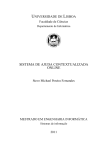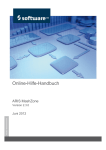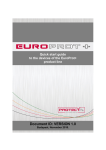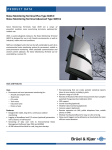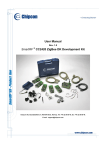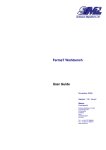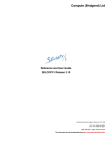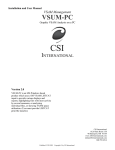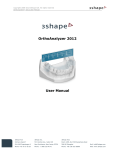Download Modernize Your Core COBOL Applications with
Transcript
April 2008
Modernize Your Core COBOL Applications with webMethods
EntireX
By Jürgen Lind, Senior Product Manager, webMethods EntireX, Software AG
In order to quickly offer new products and services to clients, businesses today
need a great deal of flexibility. For a long time they could rely on their core
COBOL applications to meet their business needs. However, these applications,
with their lengthy change cycles, are not flexible enough; they cannot support
the rapidly changing business models driven by increasing competitive
pressures. Yet replacing these core systems does not make sense—the ROI is
just not there, and they still contain a wealth of information central to the
business. With globalization, the business need is stronger than ever to
effectively leverage the information and intelligence these systems contain. A
classic example is the airline reservation system that now needs to also support
a comprehensive range of travel services today – a far different business
requirement than when these systems were originally designed and
implemented.
We need a way to easily leverage the investments in these applications in order
to gain new business and increase the business competitiveness. With
webMethods EntireX you can quickly transform the flexibility of your core
COBOL applications—allowing you to deliver new business services in just a few
days or weeks. The latest EntireX release provides even more enhanced COBOL
support for maximum business readiness. Based on webMethods EntireX RPC
technology, EntireX is both reliable and modern, providing state-of-the-art
mainframe integration with over 10 years proven performance and robustness
in many mission critical environments.
Using EntireX you can integrate your core COBOL applications with webMethods
ESB, Web services, Java, .NET and other environments to reach a broad range
of COBOL transactions. The bi-directional integration allows you, for example,
to use a Web service to call a COBOL transaction and (vice versa) have a
COBOL program call a Web service. In addition, your developer’s productivity is
greatly enhanced with the EntireX Workbench, the 100% Eclipse-based
development environment. EntireX Workbench is user-friendly and provides
wizards, views and an optimized user interface for increased efficiency. You are
Modernize Your Core COBOL Applications with webMethods EntireX
Page 1 of 7
able to quickly deliver new business services because webMethods EntireX
integrates useful tools with its comprehensive COBOL support, so you can:
¾ Use local or remote mainframe PDS source files.
¾ Extract server interfaces directly from COBOL sources and
copybooks.
¾ Perform user-driven mapping.
¾ Automatically deploy server mapping.
¾ Automatically generate client and server code.
¾ Directly test your server connection or implementation.
This article provides an overview of the webMethods EntireX COBOL mainframe
solution, touching on the comprehensive COBOL support it provides. We also
note the tools and features of highest interest.
webMethods EntireX COBOL Technical Overview
The webMethods EntireX COBOL mainframe solution uses the Software AG IDL
Extractor for COBOL and the EntireX COBOL Wrapper. The Software AG IDL
Extractor for COBOL inspects the COBOL sources and copybooks, extracts IDL
from the server sources and generates the desired client interface. The EntireX
COBOL Wrapper encapsulates functionality to provide bi-directional RPC
connectivity between the mainframe and other sources. With EntireX you can
reach many types of mainframe transactions, e.g. CICS, Batch, IMS; z/OS,
z/VSE. EntireX provides enhanced support for COBOL Interface Types (Figure 1)
and COBOL syntax, user-driven mapping, as well as asynchronous and reliable
message wrapping.
EntireX supports these COBOL Interface Types:
CICS with DFHCOMMAREA Calling Convention (for DPL enabled)
CICS with DFHCOMMAREA and Different IN / OUT Structures
CICS with DFHCOMMAREA Large Buffer Interface** / ***
CICS with DFHCOMMAREA Large Buffer and Different IN / OUT Structures
CICS with Channel Container Calling Convention**
Batch with Standard Linkage Calling Convention
IMS BMP with Standard Linkage Calling Convention (with PCB pointers)
Other interface types can be supported by means of a custom wrapper
**This allows us to exceed the 32K limit.
***This interface is the same as the webMethods WMTLSRVR interface of webMethods
Mainframe (MIS).
Figure 1: EntireX-supported COBOL Interface Types
Modernize Your Core COBOL Applications with webMethods EntireX
Page 2 of 7
Software AG IDL Extractor for COBOL
The Software AG IDL Extractor for COBOL has wizards, tools, editors and
generators (Figure 2) that allow you to easily extract and map the Software AG
Interface Definition Language (IDL), and deploy, validate and test the results.
The Software AG IDL can be extracted from either local or remote mainframe
PDS sources; the extractor wizard inspects COBOL sources and related
copybooks for data items to be extracted. You can specify the COBOL data
items that form the COBOL INOUT parameters of your server program (Figure
3). The process generates two related files, referred to as IDL and SVM:
¾ The IDL file is the Software AG IDL (interface definition
language) file containing the modeled interface of the COBOL
server. This file will be the starting point for the RPC clientside wrapping generation tools that generate the client
interface objects.
¾ The SVM file is the Software AG server mapping file that
completes the mapping and it is required by the RPC server
during runtime to call the COBOL server. With the EntireX
Workbench deployment wizard you can deploy the server
mapping to the RPC server.
Figure 2: The Software AG IDL Extractor for COBOL Wizard and Mapping Editor
Modernize Your Core COBOL Applications with webMethods EntireX
Page 3 of 7
Figure 3: Select COBOL Parameters
The Software AG IDL Extractor for COBOL wizard allows you to:
Access COBOL source files from either local or remote
mainframe PDS members; to aid your source file/member
selection, you can browse your directories (locally) or the
mainframe PDS sources (remotely). In addition, you have the
option to save remote COBOL sources to your local
environment.
Resolve COBOL copybooks and copybooks with the REPLACE
option.
Manually select and map the COBOL server interface (using
the Mapping Editor); this allows extraction when the interface
definition has not been completely given making automatic
parameter detection impossible.
Define default mapping for pseudo-parameter FILLER fields
and alphanumeric fields.
The Software AG IDL Extractor for COBOL can map most COBOL data types,
including:
Condition Names – LEVEL 88 Data Items (supports userdefined mapping for constants, map to operation).
Modernize Your Core COBOL Applications with webMethods EntireX
Page 4 of 7
SIGN LEADING and TRAILING SEPARATE Clause.
Tables with Variable Size - DEPENDING ON Clause
("unbounded arrays").
Unstructured Data Types - LEVEL 77 Data Items.
REDEFINE (supports user-defined mapping).
Mapping Editor
The IDL Extractor for COBOL Mapping Editor (Figure 4) is the tool to map the
COBOL server interface to the Software AG IDL. The Mapping Editor GUI
supports the user-driven mapping process and allows users to define mappings
that fit their business needs right from the start. In addition, sometimes COBOL
source programs do not contain all the information needed for IDL mapping, so
you can also use the Mapping Editor to manually enter any missing data. The
Mapping Editor has user-friendly features that help speed up the process of
mapping using visual guides, such as specific icons for COBOL parameter
wrapping and Level-88 data items, as well as decision markers that alert you
where a choice is needed. In the mapping editor you can define:
Which COBOL server parameters are mapped to Software AG
IDL (select REDEFINE paths, suppress or hide unneeded
server side fields).
How COBOL server parameters are mapped to Software AG
IDL (Map to IN, OUT, INOUT).
How COBOL server parameters are provided to the COBOL
server (Map to Constants, Map to Operations).
Figure 4: Software AG IDL Extractor for COBOL Mapping Editor
Modernize Your Core COBOL Applications with webMethods EntireX
Page 5 of 7
You use the "Map to Operation" for multiple business functions controlled by an
operation or function code field. If the Software AG IDL is processed further
with a workbench wrapper, then business functions can be provided as Web
service operations (if exposed as a Web service) or methods (if wrapped with
the Java or .NET wrappers).
Software AG Server Mapping Deployment
Deployment of Software AG server mapping files is supported by a wizard; this
requires an active RPC server and an RPC server deployment service. Manual
deployment is also possible with FTP and IDCAMS.
EntireX COBOL Wrapper
The EntireX COBOL Wrapper enables development of both clients and servers to
access RPC-based components from COBOL applications, i.e. RPC servers for
COBOL client applications and COBOL servers for any RPC client. The COBOL
Wrapper uses the COBOL interface (Figure 1) when generating the server
skeleton.
EntireX Workbench COBOL Wrapper tools generate the COBOL sources that
implement the interface objects, i.e. the functions and data types of the
interface. The generated functions can be compiled and linked with the COBOL
compiler of the target platform. The Software AG IDL file describes the RPC
interface and is used as input to generate the COBOL code. By using application
error codes in a standardized way, the RPC server is able to return customerdefined errors to the RPC client without needing to define IDL error code fields.
Developers use the generated client interface object(s) and copybooks to write
COBOL client applications that access RPC servers. For COBOL server
applications, developers use the generated server skeleton to write their own
server code for each program in the IDL.
Introduction to Reliable RPC
Reliable RPC was a customer-requested enhancement developed to provide
support for asynchronous and reliable service calls on an RPC level. With
Reliable RPC, your processes can span multiple systems or applications without
a loss of performance. It is used to send messages to a persisted EntireX
Broker service; messages described by an IDL program that contains only IN
parameters. The client and server COBOL interface objects are generated from
the IDL file using the EntireX COBOL Wrapper. Reliable RPC is enabled at
runtime; and the 8.0 RPC Server is implemented and configured in the same
way as for normal RPC. The 8.0 RPC Server and applications within will only
need regeneration if you wish to enable Reliable RPC. Now with Reliable RPC
you have the same level of user-friendly, Eclipsed-based GUI support for both
asynchronous and synchronous service calls.
Modernize Your Core COBOL Applications with webMethods EntireX
Page 6 of 7
Summary
The webMethods EntireX COBOL integration is state-of-the-art and provides
comprehensive COBOL support, performance and reliability. Its user-friendly
tools help increase productivity with point-and-click generation to rapidly
modernize your core COBOL applications. EntireX effectively bridges the gap
between your mainframe core systems and newer technologies such as BPM
and SOA, to bring the organization to new levels of business flexibility and
competitiveness. With EntireX you can fully capitalize on your mainframe
investments to quickly realize highly-competitive business products and
services today.
Glossary of Terms
BPM: Business Process Management
DPL: CICS Distributed Program Link
ESB: Enterprise Service Bus
FTP: File Transfer Protocol
GUI: Graphical User Interface
IDCAMS: An IBM program that is used to process access method services
commands
IDL: Software AG Interface Definition Language
MIS: Mainframe Integration Server; same as webMethods Mainframe
PCB: Program Communication Block - a control block that contains pointers to
Information Management System (IMS) databases.
PDS: Mainframe Partitioned Data Set
RPC: Remote Procedure Call
SOA: Service-oriented Architecture
SVM: Software AG Server Mapping file
webMethods WMTLSRVR interface: Large Buffer based CICS Server interface for
large message sizes; used by webMethods Mainframe (MIS)
Modernize Your Core COBOL Applications with webMethods EntireX
Page 7 of 7








